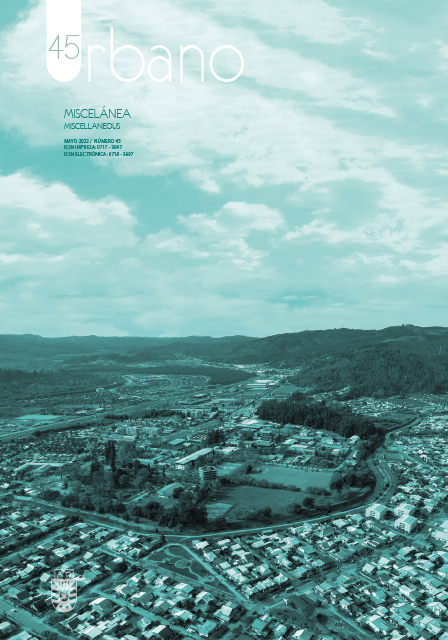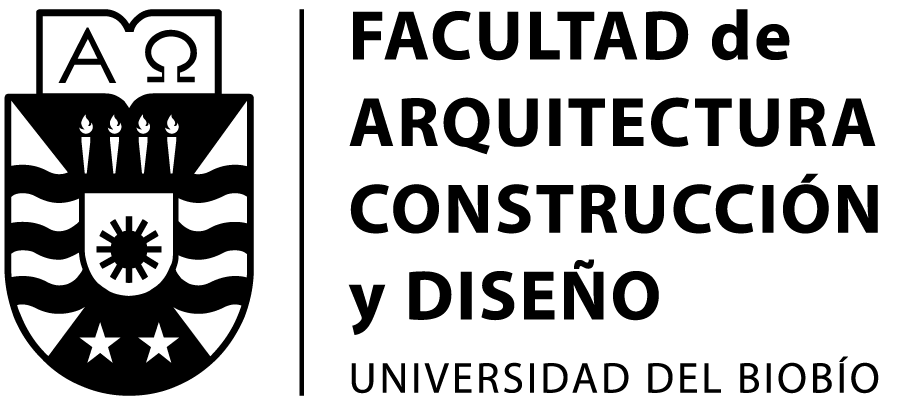Walking through the neighborhood: Understanding older people’s experiences during the pandemic, in a harsher Santiago
DOI:
https://doi.org/10.22320/07183607.2022.25.45.09Keywords:
walking, built environment, neighborhoods, Santiago de Chile, older peopleAbstract
This article aims at investigating the conditions older people face when walking through their neighborhoods. It seeks to identify the ways in which the built environment, the socio-spatial features of the neighborhoods, and the COVID-19 pandemic affect their walks. To that end, the article reports the findings of a set of interviews and focus groups where older people who reside in four neighborhoods located in the Commune of Santiago, Chile, were invited to talk about their walks and the obstacles they face when taking them. The findings show that older people consider walking a highly beneficial activity whereby they remain active, connected, and visible. They state that the processes of change that have affected their neighborhoods have transformed their landscape and social architecture, increasing fear of the public space and the feeling of loneliness. The analysis of the data also showed that older people face many obstacles when walking, including sidewalks in disrepair, hostile pedestrian crossings, and unpleasant landscapes. Those obstacles were multiplied by the arrival of the new coronavirus, which added restrictions and concerns that make walking even more difficult. The data gathered emphasizes the relevance of walking for older people, making the creation of walkable neighborhoods and their promotion in the public policies as a practice of self-care, crucial.
Downloads
References
ABUSLEME, M. y CABALLERO, M. (2014). Maltrato a las personas mayores en Chile: Haciendo visible lo invisible. Santiago: SENAMA. Recuperado de http://www.senama.gob.cl/storage/docs/Maltrato-las-personas-mayores-Chile_Haciendo-visible-lo-invisible-2014.pdf
ADAMS, C. (2012). Maltrato en el adulto mayor institucionalizado: Realidad e invisibilidad. Revista Médica Clínica Las Condes, 23(1), 84-90. DOI: https://doi.org/10.1016/S0716-8640(12)70277-8
ARANGO, C., PÁEZ, D., REIS, R., BROWNSON, R. y PARRA, D. (2013). Association between the perceived environment and physical activity among adults in Latin America: a systematic review. International Journal of Behavioral Nutrition and Physical Activity, 10(1), 1-9. DOI: https://doi.org/10.1186/1479-5868-10-122
BARNETT, D., BARNETT, A., NATHAN, A., VAN CAUWENBERG, J. y CERIN, E. (2017). Built environmental correlates of older adults’ total physical activity and walking: a systematic review and meta-analysis. International journal of behavioral nutrition and physical activity, 14(1), 1-24. DOI: https://doi.org/10.1186/s12966-017-0558-z
CHARMAZ, K. (2006). Constructing Grounded Theory. A practical guide through qualitative analysis. Londres: SAGE Publications.
Ciudad Autónoma de Buenos Aires [CABA] (2015). Manual de Diseño Urbano. Buenos Aires: Gobierno de la Ciudad Autónoma de Buenos Aires. Recuperado de https://www.buenosaires.gob.ar/sites/gcaba/files/manual_de_diseno_urbano_-_gcba_ago-2015_0.pdf
CLARKE, P., AILSHIRE, J., BADER, M., MORENOFF, J. y HOUSE, J. (2008). Mobility disability and the urban built environment. American journal of epidemiology, 168(5), 506-513. DOI: https://doi.org/10.1093/aje/kwn185
Comisión Económica para América Latina y el Caribe [CEPAL] (2007). Declaración de Brasilia. Brasilia: CEPAL. Recuperado de https://repositorio.cepal.org/bitstream/handle/11362/21505/1/S2007591_es.pdf
CORSEUIL, M., HALLAL, P., BROWNSON, R. y D’ORSI, E. (2017). Exploring associations between perceived measures of the environment and walking among Brazilian older adults. Journal of aging and health, 29(1), 45-67. DOI: https://doi.org/10.1177%2F0898264315624904
CRAMM, J., VAN DIJK, H. y NIEBOER, A. (2018). The creation of age-friendly environments is especially important to frail older people. Ageing & Society, 38(4), 700-720. DOI: https://doi.org/10.1017/S0144686X16001240
ESPINOSA, R., IBACETA, A., MEZA, D., SILVA, J. y URZÚA, J. (2015). ¿Los tiempos de los semáforos ubicados en Santiago de Chile, permiten que las personas adultas mayores crucen las calles con seguridad? 6° Encuentro Anual Sociedad Chilena de Políticas Públicas, Santiago de Chile.
FADDA, G. y CORTÉS, A. (2009). Hábitat y adulto mayor: el caso de Valparaíso. Revista Invi, 24(66), 89-113. DOI: http://dx.doi.org/10.4067/S0718-83582009000200003
FOSSEY, E., HARVEY, C., MCDERMOTT, F. y DAVIDSON, L. (2002). Understanding and evaluating qualitative research. Australian & New Zealand Journal of Psychiatry, 36(6), 717-732. DOI: https://doi.org/10.1046%2Fj.1440-1614.2002.01100.x
FRANKE, T., SIMS-GOULD, J., CHAUDHURY, H., WINTERS, M. y MCKAY, H. (2019). ‘It makes your life worthwhile. It gives you a purpose in living’: mobility experiences among active older adults with low income. Ageing & Society, 39(8), 1639-1666. DOI: https://doi.org/10.1017/S0144686X18000181
FUENTES-GARCÍA, A., SÁNCHEZ, H., LERA, L., CEA, X. y ALBALA, C. (2013). Desigualdades socioeconómicas en el proceso de discapacidad en una cohorte de adultos mayores de Santiago de Chile. Gaceta Sanitaria, 27(3), 226-232. DOI: https://doi.org/10.1016/j.gaceta.2012.11.005
GAJARDO, J., NAVARRETE, E., LÓPEZ, C., RODRÍGUEZ, J., ROJAS, A., TRONCOSO, S. y ROJAS, A. (2012). Percepciones de personas mayores sobre su desempeño en el uso de transporte público en Santiago de Chile. Revista Chilena de Terapia Ocupacional, 12(1), 88-102. DOI: http://dx.doi.org/10.5354/0717-6767.2012.22055
GEDDES, A., PARKER, C. y SCOTT, S. (2018). When the snowball fails to roll and the use of ‘horizontal’ networking in qualitative social research. International Journal of Social Research Methodology, 21(3), 347-358. DOI: https://doi.org/10.1080/13645579.2017.1406219
GONZÁLEZ, S. (2004). Actividades y salud en el espacio público: El servicio higiénico, un equipamiento urbano no asumido. El caso del centro de Santiago. Revista de Urbanismo, (10), 34-72. Recuperado de https://revistaurbanismo.uchile.cl/index.php/RU/article/view/5093
GRAHAM, H., DE BELL, S., FLEMMING, K., SOWDEN, A., WHITE, P. y WRIGHT, K. (2020). Older people's experiences of everyday travel in the urban environment: a thematic synthesis of qualitative studies in the United Kingdom. Ageing & Society, 40(4), 842-868. DOI: https://doi.org/10.1017/S0144686X18001381
HASELWANDTER, E., CORCORAN, M., FOLTA, S., HYATT, R., FENTON, M. y NELSON, M. (2015). The built environment, physical activity, and aging in the United States: A state of the science review. Journal of aging and physical activity, 23(2), 323-329. DOI: https://doi.org/10.1123/japa.2013-0151
HERRMANN-LUNECKE, M., FIGUEROA, C., PARRA, F. y MORA, R. (2021a). La ciudad del no-cuidado: caminata y personas mayores en pandemia. Revista ARQ, (109), 68-77. DOI: http://dx.doi.org/10.4067/S0717-69962021000300068
HERRMANN-LUNECKE, M., FIGUEROA, C. y VEJARES, P. (2021b). Caminata y vejez: explorando el espacio público peatonal de las personas mayores en los instrumentos de planificación urbana en Chile. URBE, 13, 1-17. DOI: https://doi.org/10.1590/2175-3369.013.e20210128
HERRMANN-LUNECKE, M., MORA, R. y VEJARES, P. (2020). Identificación de elementos del paisaje urbano que fomentan la caminata en Santiago. Revista de urbanismo, (43), 4-25. DOI: https://doi.org/10.5354/0717-5051.2020.55975
HIGUERAS, E., ROMÁN, E. y FARIÑA, J. (2021). Guidelines for Healthier Public Spaces for the Elderly Population: Recommendations in the Spanish Context. En J. Martínez, C. Mikkelsen y R. Phillips (Eds). Handbook of Quality of Life and Sustainability (pp. 35-51). Springer, Cham.
Instituto Nacional de Estadísticas [INE] (2017). Censos de Población y Vivienda. Santiago de Chile.
Instituto Nacional de Estadísticas [INE] (2018). Estimaciones y Proyecciones de la Población de Chile 1992-2050. Total País. Santiago de Chile.
LEE, L., AVIS, M. y ARTHUR, A. (2007). The role of self-efficacy in older people's decisions to initiate and maintain regular walking as exercise—Findings from a qualitative study. Preventive medicine, 45(1), 62-65. DOI: https://doi.org/10.1016/j.ypmed.2007.04.011
NYMAN, S., BALLINGER, C., PHILLIPS, J. y NEWTON, R. (2013). Characteristics of outdoor falls among older people: a qualitative study. BMC geriatrics, 13(1), 1-14. DOI: https://doi.org/10.1186/1471-2318-13-125
OLIVI, A., FADDA, G. y REYES, V. (2016). Movilidad urbana y calidad de vida de las personas mayores en una ciudad vertical. El caso de Valparaíso, Chile. Revista Márgenes Espacio Arte y Sociedad, 13(19), 38-47. DOI: https://doi.org/10.22370/margenes.2016.13.19.1033
Organización de los Estados Americanos [OEA] (2015). Convención Interamericana de Protección de los Derechos de las Personas Mayores. OEA.
Pontificia Universidad Católica de Chile [PUC] y Caja Los Andes (2020). Encuesta Nacional Calidad de Vida en la Vejez. PUC, Santiago de Chile. Recuperado de https://www.cajalosandes.cl/cs/groups/public/documents/document/cmvz/ltiw/~edisp/chile-mayores-20202.pdf
Programa de las Naciones Unidas para el Desarrollo [PNUD] y Ministerio de Vivienda y Urbanismo [MINVU] (2017). La dimensión humana del espacio público. Ministerio de Vivienda y Urbanismo, Santiago de Chile. Recuperado de https://www.minvu.cl/wp-content/uploads/2019/08/La-dimension-humana.pdf
Secretaría de Desarrollo Agrario, Territorial y Urbano [SEDATU] y Banco Interamericano de Desarrollo [BID] (2018). Manual de Calles. Ciudad de México: Secretaría de Desarrollo Agrario, Territorial y Urbano. Recuperado de https://www.gob.mx/sedatu/documentos/manual-de-calles-diseno-vial-para-ciudades-mexicanas
STRAUSS, A. Y CORBIN, J. (1990). Basics of qualitative research. Grounded theory procedures and techniques. Newbury Park: SAGE Publications.
United Nations [UN] (2002). Political Declaration and Madrid International Plan of Action on Ageing.
VECCHIO, G., CASTILLO, B. y STEINIGER, S. (2020). Movilidad urbana y personas mayores en Santiago de Chile: el valor de integrar métodos de análisis, un estudio en el barrio San Eugenio. Revista de urbanismo, (43), 26-45. Recuperado de https://revistaurbanismo.uchile.cl/index.php/RU/article/view/57090
WARMOTH, K., LANG, I., PHOENIX, C., ABRAHAM, C., ANDREW, M., HUBBARD, R. y TARRANT, M. (2016). ‘Thinking you're old and frail’: a qualitative study of frailty in older adults. Ageing & Society, 36(7), 1483-1500. DOI: https://doi.org/10.1017/S0144686X1500046X
Word Health Organization [WHO] (2015). World report on ageing and health. World Health Organization.
Yen, I. y Anderson, L. (2012). Built environment and mobility of older adults: important policy and practice efforts. Journal of the American Geriatrics Society, 60(5), 951-956. DOI: https://doi.org/10.1111/j.1532-5415.2012.03949.x
Downloads
Published
How to Cite
Issue
Section
License
Copyright (c) 2022 Marie Geraldine Herrmann Lunecke, Cristhian Figueroa-Martínez, Francisca Parra-Huerta

This work is licensed under a Creative Commons Attribution-ShareAlike 4.0 International License.
The content of articles which are published in each edition of Habitat Sustentable, is the exclusive responsibility of the author(s) and does not necessarily represent the thinking or compromise the opinion of University of the Bio-Bio.
The author(s) conserve their copyright and guarantee to the journal, the right of first publication of their work. This will simultaneously be subject to the Creative Commons Recognition License CC BY-SA, which allows others to share-copy, transform or create new materials from this work for non-commercial purposes, as long as they recognize authorship and the first publication in this journal, and its new creations are under a license with the same terms.![]()























